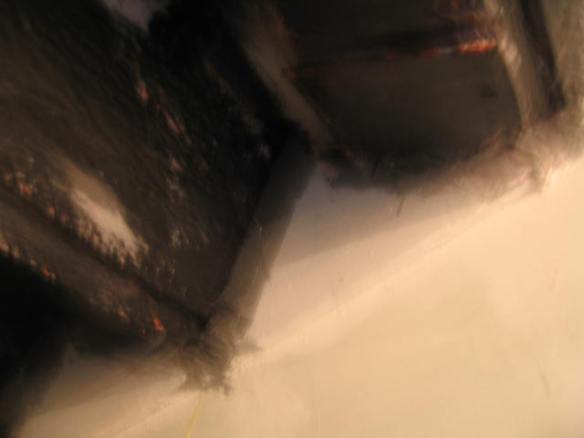 The work of abstract painter Richard Smith who exhibited recently at Flowers East Gallery in London has variously been referred to as Postminimalist, Postpainterly or Situationist. His work spans several decades of experimental painting, exploring relationships between painting and space, making constructed drawings and prints and three-dimensional paintings which investigate how the possibilities of painting and two-dimensional surface could have sculptural presence through the manipulation of materials. Variously shaped canvases such as Piano (1963) for example, extend into the gallery space from the wall, where Smith adopts manipulative approaches including cutting and folding whilst considering relationships between colour and surface.
The work of abstract painter Richard Smith who exhibited recently at Flowers East Gallery in London has variously been referred to as Postminimalist, Postpainterly or Situationist. His work spans several decades of experimental painting, exploring relationships between painting and space, making constructed drawings and prints and three-dimensional paintings which investigate how the possibilities of painting and two-dimensional surface could have sculptural presence through the manipulation of materials. Variously shaped canvases such as Piano (1963) for example, extend into the gallery space from the wall, where Smith adopts manipulative approaches including cutting and folding whilst considering relationships between colour and surface.
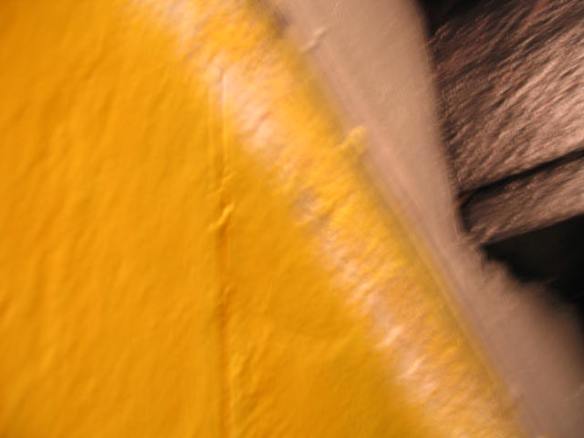 In the 1970s Smith experimented with ideas of ‘walk-in paintings’ inspired by and situated in different architectural forms and environments. His work is possibly better known through his interruptions of large public spaces in a painterly way: hanging work high above the viewer in architectural sites such as airports and museums, where it becomes a visual membrane which emphasizes instabilities of light and space. As site-specific painting, the work suggests a collaboration between site and painterly physicality. In other works, with titles such as Radio and Monitor, it evokes the domestic space.
In the 1970s Smith experimented with ideas of ‘walk-in paintings’ inspired by and situated in different architectural forms and environments. His work is possibly better known through his interruptions of large public spaces in a painterly way: hanging work high above the viewer in architectural sites such as airports and museums, where it becomes a visual membrane which emphasizes instabilities of light and space. As site-specific painting, the work suggests a collaboration between site and painterly physicality. In other works, with titles such as Radio and Monitor, it evokes the domestic space.

I was drawn to the idea of testing a certain painterly ‘architectonic abstraction of the Situation sort’ through which Smith’s work had been considered in his 1996 exhibition at Bernard Jacobson Gallery. As part of a recent overhaul of an understairs cupboard, I decided to pursue the idea of a walk-in painting, focusing on a detail of one of Richard Smith’s works to create a sense of disoriented scale and reversed architecture. Initially appropriating details of Smith’s Burn the Boxes (1995), as the project developed its relationships between colour and structure, it expanded in ambition to incorporate other elements of Smith’s works such as the use of a limited complimentary tonal range in Cabana (1996).
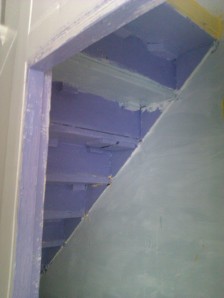
Whilst Smith’s ‘kite’ works appeared to fly above the viewer and push outward in a ‘visual, rhythmic alliteration’ (according to Bryan Robertson in the exhibition catalogue ), my cupboard- under-the-stairs installation would draw on its uncanny tropes to pull the viewer inwards toward an immersive space of formal possibility. Its poetics of space would not so much ‘propose a dialectic between the outside and inside’ but be more of a consideration of a certain ‘intimate immensity’.
There was something about an investigation of the uncanny that seemed to be emerging – a kind of gestural estrangement (in a painterly way) of the most interior of domestic spaces. Instead of recycling bags, vacuum cleaners or half empty paint pots, the viewer finds themselves instead entering and penetrating a detail of a postminimalist abstract painting. Uncanny sensations may emerge within certain psychical conditions evoked by a correlation between the absence of the familiar (dusters, sweeping brushes, abandoned coats and umbrellas, etc) and the unfamiliar (the gestural vulnerability of a painterly surface).
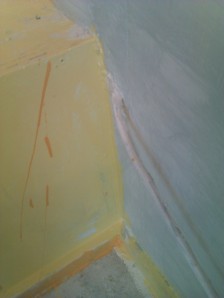 Such de-familiarisation of the postminimalist kind, may prompt a series of uncanny responses of unease, uncertainty and critical disturbance. It is evident that there are tropes of resemblance to a certain form of abstract painting from the 1970s yet the space is somehow supplementary, a prosthetic, even a form of doppelganger uprooted in time and space, provoking sensations of ‘I know, but nevertheless…’. In addition, the viewer is unable to draw back far enough to assess this inauthentic ‘crisis of the proper’ leaving her only able to confront her own anxious disavowal in a chaos of liminality.
Such de-familiarisation of the postminimalist kind, may prompt a series of uncanny responses of unease, uncertainty and critical disturbance. It is evident that there are tropes of resemblance to a certain form of abstract painting from the 1970s yet the space is somehow supplementary, a prosthetic, even a form of doppelganger uprooted in time and space, provoking sensations of ‘I know, but nevertheless…’. In addition, the viewer is unable to draw back far enough to assess this inauthentic ‘crisis of the proper’ leaving her only able to confront her own anxious disavowal in a chaos of liminality.
I reflected on the potential affects of the whole house becoming a detailed view of an invented postminimalist surface. What some may perceive as sloppy decorating, but what is in fact a focus on the accumulations, drips and smudges of indeterminacy and intuitive completion – and completely unpractical – it could also be seen as an improvisation of Erwin Panofsky’s argument of painting’s lack of intrinsic meaning, being instead a moving document whose surfaces are continually re-interpreted. That certainly does seem to be the case on my kitchen floor.
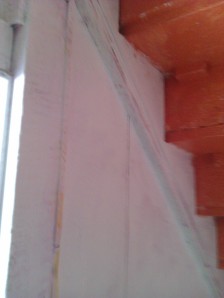 An interrogation between painting and space in terms of spectacle is being currently developed in a different way by a final year MA Fine Art painting student. Through a series of meticulously constructed miniature scale models aligned to the exhibition space, relationships between the presentation of a series of works and how they may be viewed are being explored and assessed. There is an analytical process underway that questions the function of the exhibition as event within the defining formal elements of its architectural context: floor and wall surfaces, sources of light and ceiling height have all been reproduced in scaled-down detail in order to evaluate the possible physical relationships between painting and its viewing space.
An interrogation between painting and space in terms of spectacle is being currently developed in a different way by a final year MA Fine Art painting student. Through a series of meticulously constructed miniature scale models aligned to the exhibition space, relationships between the presentation of a series of works and how they may be viewed are being explored and assessed. There is an analytical process underway that questions the function of the exhibition as event within the defining formal elements of its architectural context: floor and wall surfaces, sources of light and ceiling height have all been reproduced in scaled-down detail in order to evaluate the possible physical relationships between painting and its viewing space.
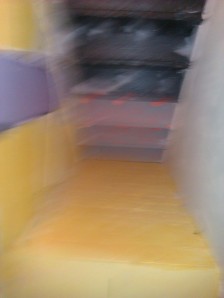
One might argue that approaches to critiquing exhibition conventions were exhausted in the 20th century through the terms of Surrealism, installation and performance art, either by artists or curators, and that there is now a ‘revisionist turn’ in exhibition design and curatorial approaches. In the catalogue of the recent exhibition of 5 contemporary painters, Painting Now at Tate Britain for example, painting is proposed as a medium undergoing ‘de-specification’. It sits alongside cinema, fashion design, film, performance, architecture and curating, navigated around processes of trompe l’oeil in a posture of intentioned detachment.
The catalogue has cited these contemporary works as situated within a field of striation, which according to philosopher Gilles Deleuze is a spatial terrain that is continuously translated and traversed. In these terms, my cupboard-under-the-stairs project could be argued within the provisions of not only a configuration of citational surface but the very embodiment of a process of de-territorialisation.
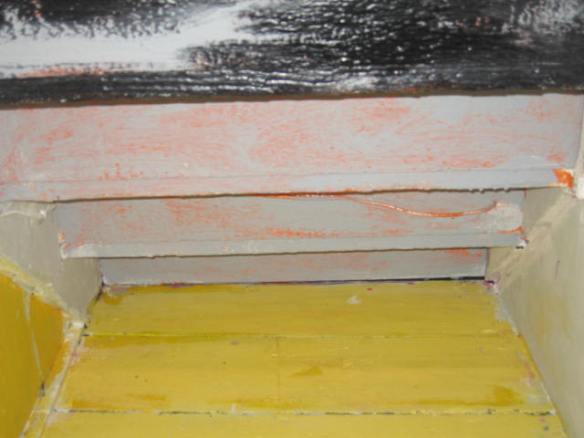
Revelant Links: Richard Smith, Situationist, Gaston Bachlard, The Uncanny, Painting Now, Gilles Deleuze
